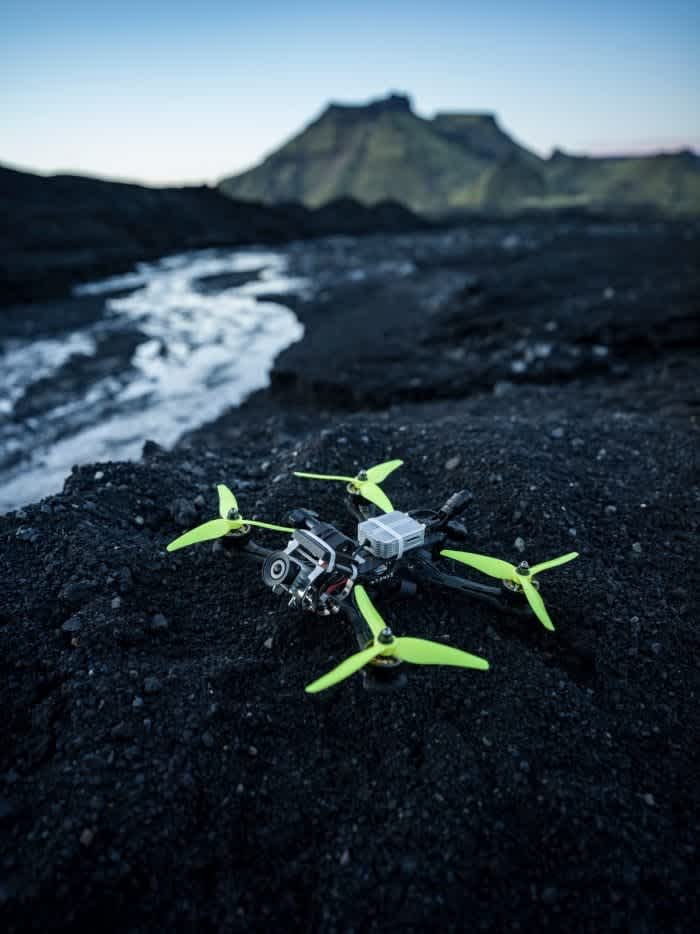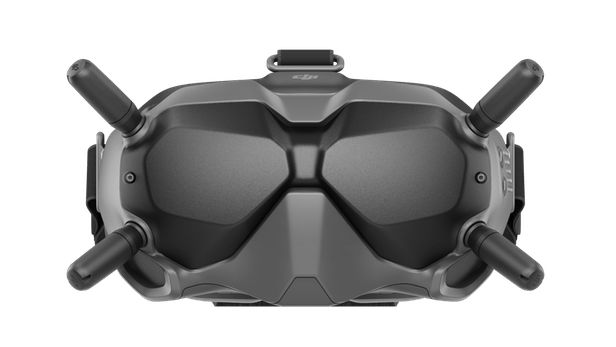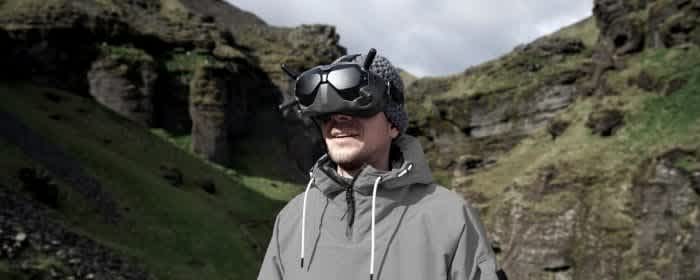
Updated on 17 Sep 2024
FPV Racing Drones: A Thrilling Experience
A guide to the thrills and spills of first-person-view racing drones, following the launch of the DJI Digital FPV System - available to pre-order from Heliguy. ... Read More

UPDATE: This post, originally posted on August 2, 2019, has been updated to include the March 2021 launch of the DJI FPV drone.
Exhilarating, thrilling and intense - the high-octane sport of first-person-view (FPV) drone racing has really taken off at both amateur and professional levels.
Looking for the DJI FPV Drone and Accessories? Click Here.
While this skilled and immersive way of flying a drone is relatively new, its popularity has helped the official Drone Racing League (DRL) establish itself as a regular feature on sports networks such as Sky Sports, NBC Sports and Fox Sports Asia.
And the popularity of FPV racing has inspired global drone giant DJI to get in on the act, most recently with the impressive FPV Drone.

Watch our review video, or read our hands-on review blog.
With this in mind, what exactly is drone racing and how does FPV enhance your flying experience? Our beginner's guide will give you an insight into this ever-increasing sport and the best ways to maximise your FPV flights.
What Is Drone Racing?
Drone racing is a sport where remote-controlled aircraft (usually quadcopters) are piloted around short courses at high speeds.

A drone racing course.
Pilots steer from the point of view of the drone by wearing FPV goggles that display a live image transmitted by an onboard state-of-the-art camera, opening up a new world of unparalleled flight experience.
This video below - taken from the DRL which boasts some of the world's most-skilled pilots battling to complete the courses and avoid obstacles in the quickest time possible - shows just how thrilling the sport can be.
Drone racing doesn't just need to be staged in stadiums though. You can compete almost anywhere, turning your local park or garden into a race track with the right equipment and some imagination.
However, it is important to stay legal and fly responsibly. For more information about the rules and regulations, read our UK FPV Drone Laws blog.
The popularity in the UK alone is demonstrated by this map, courtesy of fpvuk.org, with the coloured pins indicating things such as FPV racing clubs and interested flyers.

Because races often involve a number of pilots, this sport is incredibly social. It can also be very exciting for spectators, particularly if big screens are available to give them the live pilot’s view in real-time.
How Fast Can Racing Drones Fly?
One of the most exciting things about drone racing is the speed of the drones themselves, with some of the world's best pilots flying quadcopters through 3D courses at speeds of up to 120mph.

However, the top speed of your drone will be factored by a combination between motor, propeller and weight, as well as your battery. Here is a breakdown of what these elements are.
Frame: The frame is the main structure of the drone where the other components are mounted onto. The frame is usually a lightweight x-shaped section made from carbon fiber.
Motors: The motors are mounted to the arms of the frame ready to power the propellers. Generally, brushless motors are used for FPV drones because they offer high power outputs and efficiency.
Propellers: Racing drones tend to have 3-bladed propellers, which come in varying pitches depending on the power and weight of the drone. The propellers are spun at high speeds by the motors to generate thrust.
Flight Controller (FC): This is the brain of any drone. In short, it converts the inputs the pilot makes on the controller sticks into signals for the electronic speed controllers (ESC), while also taking into account data from a gyroscope and flight algorithms. FCs can be linked up to software in order to customise drone properties and influence how they respond to specific inputs detected by the gyroscope.
Electronic Speed Controllers (ESC): The ESC interprets the electrical signal generated by the FC and provides the appropriate current to each motor to produce thrust. 4-in-1 speed controllers are now commonly in use, offering improvements in drone weight and design.
Batteries: Lithium polymer batteries (LiPo) contain a high discharge rate and energy density, which makes them ideal for FPV drones. LiPo batteries are also lightweight, making them suitable for an FPV drone setup.

Racing drones are built for speed, agility and performance and skilled pilots are able to perform a variety of tricks, including flips and corkscrews.
Choosing the Right Racing Drone
A ready-to-fly (RTF) FPV drone is a great way for a beginner to get into this type of flying. The pilot can focus on honing their flying skills, rather than running into all the technical problems faced with custom-built drones.
If you go down the RTF route, it is wise to start out using an inexpensive mini drone, so it's not quite as painful if and when you crash it.

A racing drone. Picture from bestdroneforthejob.com
Thankfully, racing drones are getting cheaper and you can get your hands on one for less than £200, although choosing a winner is likely to cost a few hundred pounds more.
A look around the internet throws up a range of models, including:
Blade Inductrix FPV (Tiny Whoop class): A cheap and popular starter mini-drone.
Eachine Wizard X220 FPV: This FPV drone is durable, fast and affordable.
Walkera 210 FPV: Described as a popular entry-level RTF racing drone.
Diatone Crusader GT2 200: A very quick RTF racer.
Vortex 250 PRO: A rugged performer.
When it comes to racing and FPV flight, the drone isn't the only crucial factor. It is also important to choose the right components for the job, with some racing experts saying it is vital to spend a bit more cash on a good quality radio transmitter to control your drone and a decent standard of FPV goggles to help provide quality video.

With this in mind, what do you need to have in your FPV kit list?
Transmitter: An FPV drone transmitter translates radio signals from a remote controller to the actual movement of drone’s rotors, giving the pilot control over the throttle, pitch, roll, and yaw. The transmitter sends commands through channels, and FPV drones with more channels tend to be more expensive.
Receiver: The receiver collects the data sent from the transmitter and relays the information to the FC. A VTX video transmitter is connected to your drone’s camera and transmits a video signal to FPV goggles, headsets, and other displays in real-time.
FPV Camera: This component is what enables you to enjoy an FPV view from your drone. The FPV camera is mounted on the drone and connects to a video transmitter. Higher quality drone cameras contribute to better FPV feeds, offering a more consistent and satisfying flying experience. While different drone models have different video transmission capabilities, most will provide 720p or even 1080p live feeds to your chosen headset display.
Antenna: The antenna broadcasts the signal from the video transmitter and is tuned to a particular radio frequency for FPV racing drones.
FPV Goggles: The video transmitter sends a signal that is picked up by the antenna on the FPV goggles. The video receiver on the FPV goggles then displays this on the screen, giving the pilot an immersive sensation.
The DJI FPV Drone Combo - launched in March 2021 - is an out-of-the box solution, which comes pre-built and includes the drone, goggles, and remote controller, as well as a range of other accessories. Featuring a range of flight modes - including N Mode, which is designed for beginners - as well as the chance to hone your skills through the DJI Virtual Flight App, this package from DJI is ideal for those new to FPV flying. Catering for all abilities, the drone also has M Mode, for full on FPV manual flight.
Building Your Own Winner
Purchasing a RTF racing drone is one option. But another road to go down is building your own quadcopter. Make no mistake, it can be a difficult process - especially some of the more technical aspects of the construction - but it is rewarding, especially if you use your skills to construct a winner.

Building a racing drone can be a challenging but rewarding experience. Picture from thedroneracingleague.com
Knowing how to build a racing drone will also help if you have a crash or diagnose a problem. Being able to tinker underneath the bonnet - as it were - is certainly an advantage.
According to propwashed.com, if you are undertaking your first build, there are a number of guidelines to follow to make your life easier. These include:
Buy a frame with a good build log you can find online. You can find build logs by simply searching 'build log' on Google. This will give you something to follow when doing your build.
Buy 2205 motors known to fit your frame. You don’t want to have to modify your arms on your first build.
Buy reliable ESCs that run BLHeli. Good ESCs are the most important part of a racing drone.

Building a racing drone can be a challenging but rewarding experience. Picture from thedroneracingleague.com
To give you an idea of what it takes to build a rapid FPV racing drone, watch this video below:
Aside from the new DJI FPV Combo, DJI has previously released the Digital FPV System. It doesn't come with a drone, but the company has made items available to help you construct your own racer.


FPV Flying Is More Than Just Flying
FPV drone racing is an incredible experience. But FPV flying doesn't need to be all about the racing. Simply putting on the goggles and taking flight like a bird is a phenomenal feeling, enjoying every twist and turn of your drone through the camera's perspective.
This sensation is not just fun, but also allows the pilot to control the drone with more precision and accuracy and obtain video shots that are incredibly tricky to capture under normal flight operation and create dynamic content.

Certain missions are also enhanced through FPV. These include:
Search and Rescue: Search and Rescue has become an increasingly utilised drone application thanks to the development of FPV technology. Search and rescue teams can delegate team members with specific roles – one pilot can concentrate solely on FPV flight – while another camera operator can conduct an independent search using a dedicated second camera.
Agriculture: FPV drones aid agriculture operations by providing a dedicated FPV feed to drone pilots. This allows the second camera or imaging device to be used for other operations like capturing NDVI data, mapping images, or collecting other precise data. Agricultural FPV drones also enable easier and safer crop spraying as the pilot can automate the flight while monitoring the live FPV feed.
A number of DJI drones are available which are ready-to-fly, pre-configured and compatible with FPV DJI Goggles.

The Mavic 2 comes in two versions – the Mavic 2 Pro and the Mavic 2 Zoom – both compatible with DJI Goggles and DJI Goggles RE with the latest firmware update. Both drone models can be connected to DJI Goggles using OcuSync transmission technology, which provides a stunning 1080p live feed. Users can also enable Sport mode to enjoy FPV flight at speeds of up to 72kph.

The Mavic Air is another aircraft which can give you an immersive FPV experience, but as it doesn’t feature OcuSync, you will need to use a micro USB cable paired with a USB OTG cable to connect to DJI Goggles or DJI Goggles RE.
The DJI Spark is a mini drone which can reach speeds of up to 50kph in Sport mode. It can be easily paired with DJI Goggles (requires a USB cable).
For newbie pilots who want to learn the basic art of flying a drone, the Tello is small, fun and affordable. While it is not compatible with DJI Goggles, Tello is the perfect beginner FPV drone for those wanting a ready-to-fly experience when paired with a VR-smartphone headset.

The DJI FPV Drone And Combo
Experience the thrill of FPV flight with the DJI FPV Drone Combo - which offers an immersive flight experience and can capture cinematic FPV footage.

**Highlights include:**
Immersive flight;
Record 4K/60fps video at up to 120Mbps;
Top speed of just over 87 mph;
Low-latency HD video transmission at up to 120fps for an ultra-smooth, real-time view of your flight;
Slow motion and RockSteady stabilisation for smooth and cinematic content;
Three intuitive flight modes ensure the drone can be enjoyed by beginners, all the way through to seasoned FPV pilots;
Array of accessories, including the Motion Controller: Steer the drone with your hand movements;
The DJI FPV ecosystem is ideal for FPV drone racing and capturing cinematic FPV content.
Experience The HD Flight With The DJI Digital FPV System
Whether you're using an FPV drone for racing or to simply experience the thrill of FPV flight, the DJI Digital FPV System was launched a few years ago to maximise your experience.

This system includes four main components - an air unit, FPV camera, goggles, and remote controller - all designed to work together to achieve amazing results. This includes DJI HD Low Latency FPV Transmission, reaching video transmission latency as low as 28ms and latency between the air unit and RC as low as 7ms.
Read more about the DJI Digital FPV System
This minimised latency ensures almost real-time responsiveness and a clear, HD feed while you're zooming through an FPV drone course. With additional features like a pair of goggles with four omnidirectional antennas and eight transmission channels, the DJI Digital FPV System is set to revolutionise the FPV drone experience in ways no one has ever seen.

The DJI FPV System includes two options – the FPV Fly More Combo and the FPV Experience Combo for £809.
The FPV Fly More Combo includes the FPV Goggles, Air Unit, FPV Camera and Remote Controller, along with all the wires and antennas needed. The FPV Experience Combo includes the FPV Goggles, two FPV Camera and Air Units, along with all the necessary wires and antennas.


written by
James Willoughby
James joined heliguy™ in 2018 following a 13-year stint in print and online journalism, having worked on regional and weekly newspaper titles. He is responsible for spearheading heliguy™'s content strategy and social media delivery. James collaborates with DJI Enterprise's European marketing team to coordinate and produce case studies and helps organise events and webinars.